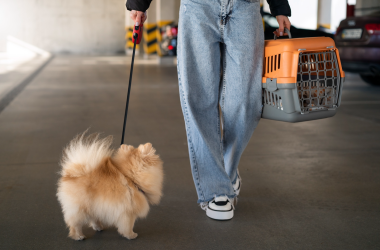Our furry friends, just like us, can feel anxious and stressed at times. A variety of factors can cause this and can negatively impact their well-being and quality of life. Your dog may display sudden aggression or no longer be willing to participate in activities they used to enjoy. As owners, we want the best for our pets, so if you are worried your dog is anxious, this article will help you understand and manage their anxiety.
Why It Happens
There are multiple reasons why a dog can experience stress. Some of these reasons are
New Environment or People
Did you recently move? You may have a new member in your family. Such changes in the environment they are used to can result in your dogs getting anxious.
Separation Anxiety
If your job or various circumstances cause you to leave your dog unattended for long periods of time, they begins to experience separation anxiety.
Phobias
Dogs can develop phobias, or fears of particular objects, people, or situations. They can start experiencing anxiety when exposed to these.
How Can You Identify Their Anxiety?
Although these symptoms are not exclusive to anxiety, they are common indicators that your dog is feeling anxious. Suppose your dog is repeatedly displaying these symptoms. In that case, it is advisable to take them to a vet to see if they do have anxiety, what type of anxiety they have, and if the anxiety is situational or if it’s becoming a serious problem for your dog.
Restlessness and Pacing
Your dog may pace back and forth or appear restless if they are feeling anxious or stressed out.
Drooling or Panting
Excessive panting or drooling can be a sign of anxiety in dogs.
Barking or Whining
Constant barking or whining is another common sign that your dog is feeling anxious.
Destructive Behavior
Exhibiting destructive behaviors like chewing or digging can sometimes be due to stress and anxiety.
What You Should Do
There are measures you can take to help your dog overcome or manage their anxiety. Simple things like regularly exercising with them or engaging in physical activities can help reduce their anxiety. You can also provide calming aids such as calming treats or pheromone diffusers.
Visit this website to get a variety of calming treats to help your dog. If a specific object or person causes your dog’s anxiety, try removing it. If that is not possible, gently desensitizing and exposing them to the source while praising and reassuring them can reduce the anxiety surrounding such things.
While you can do a lot yourself, you should still pay a visit to the vet so your dog can get diagnosed and get medication if necessary. You can also consider getting your dog a companion if your situation allows you.
It is not an easy process; instead, it requires patience and understanding. However, because we love our dogs and want the best for them, we are willing to put in the effort to help. By identifying the cause, quickly recognizing the signs, and then taking effective action, dog owners can improve their dogs’ mental health and well-being.
















